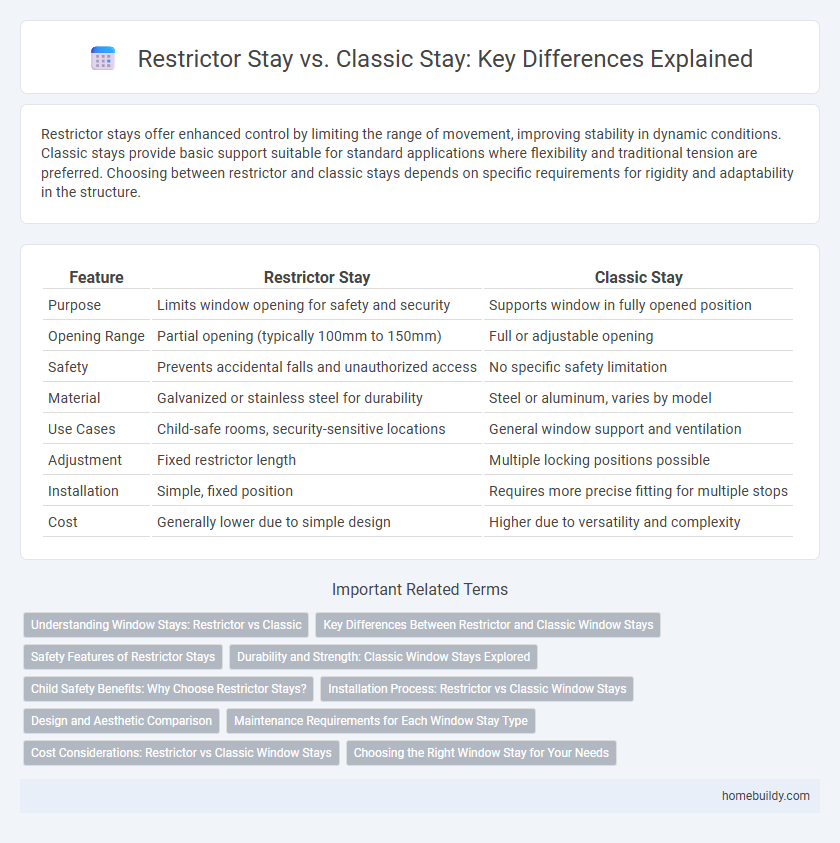Restrictor stays offer enhanced control by limiting the range of movement, improving stability in dynamic conditions. Classic stays provide basic support suitable for standard applications where flexibility and traditional tension are preferred. Choosing between restrictor and classic stays depends on specific requirements for rigidity and adaptability in the structure.
Table of Comparison
| Feature | Restrictor Stay | Classic Stay |
|---|---|---|
| Purpose | Limits window opening for safety and security | Supports window in fully opened position |
| Opening Range | Partial opening (typically 100mm to 150mm) | Full or adjustable opening |
| Safety | Prevents accidental falls and unauthorized access | No specific safety limitation |
| Material | Galvanized or stainless steel for durability | Steel or aluminum, varies by model |
| Use Cases | Child-safe rooms, security-sensitive locations | General window support and ventilation |
| Adjustment | Fixed restrictor length | Multiple locking positions possible |
| Installation | Simple, fixed position | Requires more precise fitting for multiple stops |
| Cost | Generally lower due to simple design | Higher due to versatility and complexity |
Understanding Window Stays: Restrictor vs Classic
Restrictor stays limit window opening for enhanced safety and ventilation control, making them ideal for child-safe environments and secure air circulation. Classic stays allow full window opening, offering maximum airflow and ease of cleaning while maintaining structural support. Choosing between restrictor and classic stays depends on prioritizing safety, ventilation needs, and ease of access.
Key Differences Between Restrictor and Classic Window Stays
Restrictor stays offer enhanced safety by limiting the window opening angle, preventing accidents and unauthorized access, unlike classic stays which allow full window opening. The restrictor mechanism integrates a locking feature for controlled ventilation and security, whereas classic stays primarily focus on holding the window in place without restricting movement. Material durability and installation complexity also differ, with restrictor stays typically requiring more robust components to ensure reliable restraint and security functions.
Safety Features of Restrictor Stays
Restrictor stays enhance window safety by limiting the opening width, reducing the risk of falls, especially in homes with children or pets. Unlike classic stays, restrictor stays often include built-in locking mechanisms to prevent unauthorized or accidental full opening. These safety features make restrictor stays a preferred choice for compliance with modern building regulations and child safety standards.
Durability and Strength: Classic Window Stays Explored
Classic window stays offer superior durability and strength compared to restrictor stays, making them ideal for heavy or frequently used windows. Constructed from robust materials such as stainless steel or brass, classic stays withstand significant wear and pressure without deforming or failing. Their solid design ensures long-term performance and reliable window positioning even under harsh weather conditions.
Child Safety Benefits: Why Choose Restrictor Stays?
Restrictor stays enhance child safety by limiting how far windows can open, reducing fall risks in homes and schools. Unlike classic stays, restrictor stays maintain ventilation while ensuring children cannot open windows wide enough to cause accidents. Their secure locking mechanism offers peace of mind, making them an essential choice for child-safe environments.
Installation Process: Restrictor vs Classic Window Stays
Restrictor stays feature a more straightforward installation process, often requiring fewer fixings and less manual adjustment compared to classic stays. Classic window stays involve more complex alignment and fastening, which can extend installation time and require precise fitting to ensure stability. Both types demand secure anchoring, but restrictor stays typically offer quicker setup with integrated safety stops for controlled window opening.
Design and Aesthetic Comparison
Restrictor stays feature a sleek, minimalistic design that enhances modern window aesthetics while providing discreet security and ventilation control. Classic stays showcase a more traditional, robust build with visible hardware elements that complement period-style architecture and add decorative charm. The choice between restrictor and classic stays depends on the desired blend of contemporary subtlety versus vintage character in window design.
Maintenance Requirements for Each Window Stay Type
Restrictor stays generally require less maintenance due to their simpler hinge and locking mechanism, reducing the risk of wear and tear compared to classic stays. Classic stays, featuring multiple locking points and more complex metal arms, demand regular lubrication and inspections to prevent rust and ensure smooth operation. Proper upkeep of both types extends window lifespan but restrictor stays offer a more low-maintenance solution ideal for high-use or hard-to-reach windows.
Cost Considerations: Restrictor vs Classic Window Stays
Restrictor stays typically incur higher initial costs due to their advanced safety features and enhanced security mechanisms compared to classic stays. Classic window stays offer a more budget-friendly option with simpler designs but may require more frequent maintenance, potentially increasing long-term expenses. Considering total ownership costs, restrictor stays provide better value in settings prioritizing safety and compliance despite their upfront premium.
Choosing the Right Window Stay for Your Needs
Choosing the right window stay depends on factors like security, ventilation control, and ease of use. Restrictor stays offer enhanced safety by limiting the window opening size, making them ideal for households with children or high-security needs. Classic stays provide a traditional look and straightforward operation, suitable for spaces prioritizing style and simple ventilation over enhanced security features.
Restrictor stay vs Classic stay Infographic

 homebuildy.com
homebuildy.com